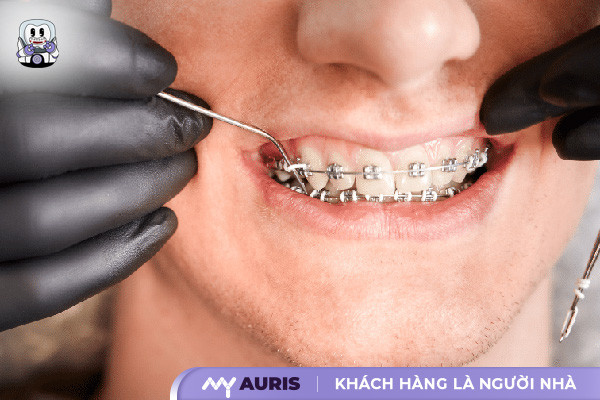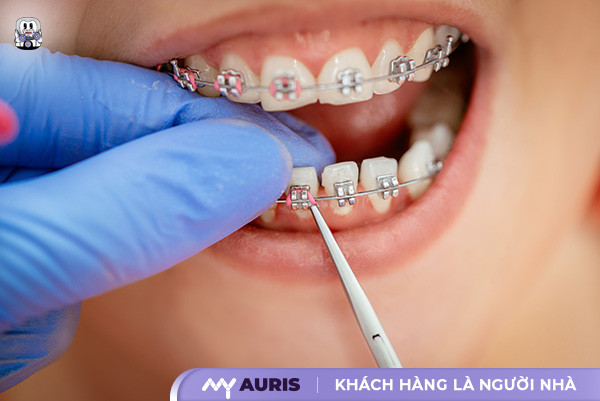If you desire straight, naturally beautiful teeth and an ideal bite, then braces are the safest and most effective choice available today. To meet the growing demand for aesthetics, safety, and treatment effectiveness, modern dentistry has developed many advanced orthodontic methods, suitable for various dental conditions.
What are Braces?
Braces (orthodontic treatment) are a modern cosmetic dentistry method that uses a system of archwires, brackets, clear aligners, and specialized appliances to straighten teeth, moving them into their correct positions on the dental arch. This is an effective solution to improve conditions such as overbite, gapped teeth, underbite, crowded teeth, and malocclusion, resulting in straight, beautiful teeth and a radiant, confident smile.
Previously, metal braces were the most common choice in orthodontic treatment. However, due to aesthetic concerns and inconvenience in daily life, this method has become less popular. Modern dentistry has continuously innovated, introducing many advanced orthodontic methods such as clear aligners, making it easier for users to choose an option that suits their individual needs. As a result, today’s patients have a wider range of choices and enjoy a more comfortable and effective orthodontic experience than ever before.

4 Popular Aesthetic Orthodontic Methods Today
In the field of orthodontics, there are currently 4 popular aesthetic braces methods: metal braces, ceramic braces, lingual braces, and Invisalign. Each method has its unique characteristics, along with different advantages and disadvantages. Choosing the right option will depend on your current dental condition and specific orthodontic requirements. Understanding each method will help you make an informed decision that suits your needs and ensures optimal aesthetic results.

Metal Braces
Metal braces are an orthodontic method that uses a system of metal brackets combined with archwires to create a pulling force, thereby moving teeth to their desired positions on the dental arch. This is a common orthodontic technique suitable for a wide range of patients and various dental conditions.
This method is divided into two main types:
Traditional Metal Braces (Ligature Braces)
Characteristics: Uses elastic ligatures to secure the archwire into the bracket slot, helping to maintain stable tension throughout the treatment process.
Advantages:
- High effectiveness in teeth straightening
- Reasonable cost, suitable for many patients
- Shorter treatment time compared to other methods
- Does not require extensive technological support
- Suitable for a variety of dental conditions
Disadvantages:
- Low aesthetic appeal due to easily visible brackets
- Can cause discomfort, easily rubbing against lips and cheeks
- Adjustments take more time

Self-ligating Metal Braces (Smart Braces)
Characteristics: An improvement over ligature braces, self-ligating metal braces use a sliding mechanism instead of elastic bands, effectively holding the archwire in place without frequent wire changes.
Advantages:
- Shortens treatment time
- Reduces the number of follow-up visits due to automatic wire retention
- More flexible pulling force adjustment, reducing discomfort
- Less prone to detachment or archwire deformation
- Low friction force, helping to reduce gum soreness
Disadvantages:
- Higher cost than ligature braces
- Aesthetic appeal is still limited
- Brackets are larger, which can cause discomfort when eating

Ceramic Braces
Ceramic braces are an orthodontic method that operates on a similar principle to metal braces, but their distinguishing feature lies in the use of high-quality ceramic material and a color that closely matches natural teeth. As a result, the brackets are almost “invisible” on the arch, helping patients maintain confidence during communication, making them particularly suitable for those who prioritize aesthetics.
Currently, there are two common types of ceramic braces:
Traditional ceramic braces: Utilize a system of brackets combined with archwires and elastic ligatures to move teeth into their correct positions. This method ensures stable, continuous pulling force, making the orthodontic process more effective.
Self-ligating ceramic braces: Have a design similar to self-ligating metal braces, but the brackets are made of ceramic material with an integrated automatic sliding cap or self-closing latch. This completely replaces elastic ligatures, helping to reduce initial soreness and optimize the experience for the patient.
Compared to metal braces, ceramic brace types offer superior aesthetic advantages and ensure safety due to the biocompatibility of the ceramic material. However, the disadvantages include higher cost, thicker brackets that can feel bulky, and susceptibility to cracking or breaking with strong impacts. Additionally, when wearing ceramic braces, meticulous oral hygiene is crucial to prevent staining from colored foods.

Lingual Braces (Invisible Braces)
Lingual braces, also known as invisible braces or braces on the tongue side, are an advanced orthodontic technology that operates on a similar principle to metal braces. However, the key difference is that the brackets and archwires are placed on the inner surface of the teeth, rather than the outer surface. As a result, patients can feel confident as their braces are virtually unnoticeable during daily communication. This method is particularly suitable for individuals who highly prioritize aesthetics, such as MCs, actors, and models – professions that require a prominent appearance and frequent public interaction.
Outstanding Advantages
- Absolute aesthetics: The brackets are hidden on the inside, allowing you to feel confident without being noticed during your orthodontic treatment.
- An ideal solution for those who need to maintain a professional image at work.
Disadvantages to Note
- Not suitable for cases with complex dental pathologies or severe malocclusions.
- Treatment duration may be longer compared to traditional (buccal) braces or clear aligners.
- More difficult to clean, requiring meticulous oral hygiene from the user.
- Requires a highly skilled and experienced orthodontist for treatment with lingual braces.

Clear Aligners
Currently, non-bracket orthodontics includes three main methods: Invisalign, Ecligner, and 3D Clear. The common feature of these techniques is the use of clear aligners made from transparent materials, which help straighten teeth without the need for traditional braces. The differences lie in their origin, operating mechanism, and specific treatment effectiveness.
Invisalign Clear Aligners
Invisalign is an advanced orthodontic solution from the U.S., developed by Align Technology, a dental medical device company. With a smart operating mechanism based on integrated force-generating attachments within the aligner trays, this method accurately moves teeth into their correct positions on the dental arch.
Typically, Invisalign treatment requires 20-40 clear aligner trays, depending on the degree of tooth misalignment. This method provides superior treatment effectiveness, successfully correcting conditions such as overbite, gapped teeth, underbite, and misalignment. However, if the cause of an overbite or underbite is skeletal, Invisalign should be combined with jaw structure surgery to achieve optimal results.
Ecligner Clear Aligners
Developed by Ecligner International Co., Ltd (South Korea), a company specializing in dental medical devices, Ecligner is a technology certified by the Korean government and numerous international medical organizations.
Unlike Invisalign, Ecligner does not use force-generating attachments, but still ensures precise force application to improve aesthetic dental conditions such as overbite, underbite, gaps, and misalignment. Throughout the treatment, patients will need to change 20-40 trays, depending on their dental condition. The cost of Ecligner treatment is lower than Invisalign, but its treatment effectiveness may be less in some complex cases.
3D Clear Aligners
As an option in the non-bracket orthodontic category, 3D Clear aligners combine elements of both Invisalign and Ecligner. Its biggest advantage is its affordable cost, making it more accessible to users, while still ensuring aesthetics and confidence in communication during the treatment process.
Unlike the two methods above, 3D Clear aligners are custom-made based on a 3D scan of tooth impressions, then pressed into transparent plastic arch models. This method is suitable for mild cases, such as slightly misaligned, minor overbite, minor underbite, or small gaps. However, its effectiveness is not complete when applied to severe conditions, and the wear time is typically longer than with Invisalign or Ecligner. For cases of overbite/underbite caused by jaw issues, treatment should be combined with orthodontic appliances or jaw surgery to achieve faster and more sustainable results.

How Much Do Braces Cost?
The cost of braces is not fixed; it varies depending on the type of braces you choose and the specific dental condition of each individual. To know the exact cost you need to prepare for braces, you should consult directly with an orthodontic specialist for thorough advice and a suitable treatment plan.
Below is the price list for braces at My Auris Dental Clinic for your reference. The price list includes both the listed prices and current promotional offers — when you undergo orthodontic treatment, you will receive the most favorable promotional price available today.
My Auris Dental Clinic Braces Price List – 2023
| Brace Type | Complexity Level | Listed Price |
| Standard Metal Braces | Level 1 | 25,000,000 |
| Level 2 | 30,000,000 | |
| Level 3 | 35,000,000 | |
| Self-ligating Metal Braces | Level 1 | 35,000,000 |
| Level 2 | 40,000,000 | |
| Level 3 | 45,000,000 | |
| Standard Ceramic Braces | Level 1 | 30,000,000 |
| Level 2 | 35,000,000 | |
| Level 3 | 40,000,000 | |
| Self-ligating Ceramic Braces | Level 1 | 50,000,000 |
| Level 2 | 55,000,000 | |
| Level 3 | 60,000,000 |





